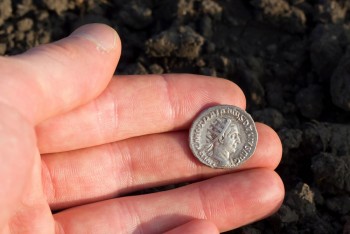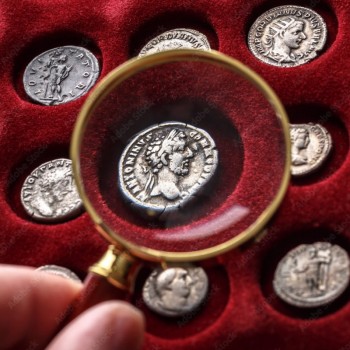
Coins are relatively common finds from archaeological excavations of Romano-British sites. Different settlement types tend to produce distinctive patterns of coin loss (eg, military and urban sites, religious sites, villas and other rural settlements), while coins are more common from some parts of Roman Britain than others.
Currently, there is no industry standard setting out the minimum requirements for Romano-British coin reports. A previous standards and guidance document for Romano-British coin reports, commissioned by English Heritage in 2004, failed to gain traction in the historic environment sector and was removed from Historic England’s website in 2015 (Brickstock 2004).
Roman coins are unique among archaeological artefacts in that they were produced by the state in order to serve the state’s needs – the emperor’s coins were issued in order to pay for the costs of the army and the civil service, to store wealth and to distribute imperial largesse, as well as to facilitate trade and commerce. Although Roman coinage changed significantly from the 1st to the 4th centuries, in theory Rome’s currency always consisted of a tri-metallic system (gold, silver and bronze), composed of interchangeable denominations of different monetary values (normally for a fee collected by money-changers). Low-value, small-change denominations are most common from archaeological excavations, whereas higher-value coins are more often found in hoards.
Almost all Roman coins can be dated to an emperor’s reign (and, in some instances, more closely to a particular year or years), and the absolute dates provided by these objects are the basis for the typological sequences of many other artefacts, as well as the dating of excavated sites.

Numismatics, the study of coins and currency, is one of the oldest historical disciplines in Western academia. Numismatic knowledge is based on the study and arrangement of coin types into chronological sequences, determined by the reigns of rulers as well as historical events. The 20th century saw a greater focus on the examination of Roman coins contained in hoards to better understand coin production and supply, as well as circulation patterns, while the analysis of coins as archaeological artefacts (‘site-finds’) developed in the UK from the 1970s (eg, Casey and Reece 1974; Casey 1986; Reece 1987; Reece 1995).
‘Applied numismatics’ is often used to describe an investigation of archaeologically recovered coins, but this term is loosely defined and can mean different things to numismatists, historians and archaeologists. For instance, the introduction to The Oxford Handbook of Greek and Roman Coinage highlights the application of numismatic knowledge to the study of history, art history and economic history, but does not mention archaeology or social history (Metcalf 2012).
In order to avoid ambiguity and confusion in the future, archaeological numismatics would be a clearer designation for the study of archaeologically recovered coins, including site-finds (see The Journal of Archaeological Numismatics).
The great variation in the content and quality of specialist archaeological artefact reports, including Roman coins, was highlighted as a significant concern in the HE-funded project 7090 Review of the Standard of Reporting on Archaeological Artefacts in England (Cattermole 2017). This project looked at over 1000 unpublished specialist artefact reports from grey literature and a further 61 published specialist artefact reports from journal articles. These were scored against a checklist of criteria to assess the reports’ overall quality, which highlighted that existing standards and guidance were not being used effectively:
- only 56% of specialist artefact reports met 50% or more of the criteria
- only 12% of specialist artefact reports met 75% or more of the criteria
- only 0.7% of specialist artefact reports met 90% or more of the criteria
Concerns about the lack of a consistent methodological approach to Roman finds reports, including coinage, were highlighted in the HE-funded Rural Settlement of Roman Britain project and related publications (Fulford and Holbrook 2018). For instance, in the discussion paper exploring the recovery, reporting and analysis of artefacts:
There is, in particular, a need for considerably greater consistency, especially concerning the full quantification of artefact assemblages, and this is of fundamental importance if we are to capitalise on and extract maximum value from the artefacts excavated from Romano-British sites.” (Brindle 2016, 1)
References
- Brickstock, R J, 2004 The Production, Analysis and Standardisation of Romano-British Coin Reports. English Heritage: Swindon
- Brindle, T, 2016 Approaches to the Investigation, Analysis and Dissemination of Work on Roman Rural Settlements and Landscapes in Britain: A Review. Paper 5: The Recovery, Reporting and Analysis of Artefacts. Cotswold Archaeology: Unpublished discussion paper. Weblink.
- Casey, J, 1986 Understanding Ancient Coins. An Introduction for Archaeologists and Historians. London: Batsford
- Casey, R and Reece, R, (eds) 1974 Coins and the Archaeologist. Oxford: British Archaeological Reports (Reprinted in 1986).
- Cattermole, A, 2017 Review of the Standard of Reporting on Archaeological Artefacts in England. Historic England Project No. 7090: Unpublished report for Historic England. Weblink (PDF).
- Fulford, M and Holbrook, N 2018 ‘Relevant Beyond the Roman Period: Approaches to the Investigation, Analysis and Dissemination of Archaeological Investigations of the Rural Settlements and Landscapes of Roman Britain’, Archaeol J, 175 (2), 214–230.
- Metcalf, W, 2012 The Oxford Handbook of Greek and Roman Coinage. Oxford: OUP
- Reece, R, 1987 Coinage in Roman Britain. London: Seaby.
- Reece, R, 1995 ‘Site-finds in Roman Britain’, Britannia, 26, 179-206.



